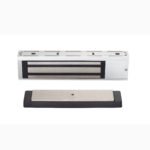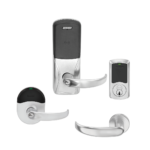It’s official! Since Mark Kuhn has achieved his EHC (Electrified Hardware Consultant) credential, I will be directing all questions on that topic to him! 🙂 Today’s post from Mark addresses the question of whether to supply battery back-up on access control doors. ~Lori
~~~
 I’ve been on a journey over the last couple of years – pursuing my EHC credential, and this journey came to a successful end a few months back when I found out that I passed the EHC exam. YAY!!!!!
I’ve been on a journey over the last couple of years – pursuing my EHC credential, and this journey came to a successful end a few months back when I found out that I passed the EHC exam. YAY!!!!!
Anyway…enough about me. 🙂
During the many classes and tutoring sessions that I have taken part in over the last couple of years, there was one thing that stood out to me. When I would draw a wiring diagram for a fail secure lock with a card reader – especially a perimeter door – the power supply was always expected to have battery back-up. This was curious to me, because as an Allegion specwriter, I almost never specified the battery back-up feature for a power supply. I wanted to know why this feature was recommended by my DHI instructors but was not something that I normally did.
My first thought was maybe it was code requirement, because let’s be honest, that’s the driving force behind most of our hardware selections. But as I looked into the codes and standards, specifically UL294 – Standard for Access Control System Units, while there is a requirement on some levels (Levels 2, 3 & 4) for “standby power”, this is not a requirement of the standard for all levels.
Because the code requirement trail did not lead to a definitive answer, I decided to ask the experts that I know in the access control field. I found that in most cases, the access control provider does have some sort of back-up power for their equipment (batteries, UPS, etc.). This means that during a power outage the card reader, access control panel, and computer server all continue to function. Even though this may not be a code requirement, it has become a “best practice” among security integrators.
Because of this I have come to the following conclusion. (Hang on – I’m going to use some EHC terms here. 🙂 ) If the switch that is controlling the load is working during a power outage, DOESN’T IT MAKE SENSE FOR LOAD TO BE OPERATIONAL AS WELL? Meaning that if my card reader has power and all the brains behind the card reader (the access control panel and the computer) have power as well, shouldn’t I have battery back-up in my power supply, so that my lock is powered also?
 A good example of this would be an exterior door with Von Duprin electric latch retraction (QEL) panic hardware that is powered by a PS902 power supply. This is a scenario that is not typically covered by a central power source (even if other openings in the building are). Quite often in this situation, the card reader is powered but the QEL panic is not. So even though the card reader is operational, you can’t get into the building with your credential. Would it be a best practice to provide battery back-up at these locations? YES!
A good example of this would be an exterior door with Von Duprin electric latch retraction (QEL) panic hardware that is powered by a PS902 power supply. This is a scenario that is not typically covered by a central power source (even if other openings in the building are). Quite often in this situation, the card reader is powered but the QEL panic is not. So even though the card reader is operational, you can’t get into the building with your credential. Would it be a best practice to provide battery back-up at these locations? YES!
Now for disclaimer time…
- As far as my research show, this is not a requirement of UL294 but more of a best practice.
- This would only apply to FAIL SECURE locks, because as iDigHardware readers know, when it comes to FAIL SAFE locks, in many cases the lock is REQUIRED to be unlocked upon loss of power.
A few more take-aways…
If you have POE (power over ethernet) locks, they must meet the requirements of UL294B, they are powered by the access control panel, and they would have standby power. This article would only apply to a localized power supply. Normally a central power supply would have back-up power. And finally, the batteries only last so long…if your area has just been through a blizzard and you’re under 10 feet of snow so the power won’t be on for weeks…you probably need a generator. This might be the reason why my good Canadian friend Richard Bradbury tells me that all access control systems in Canada require battery back-up…“Eh”
Do you agree with Mark’s assessment? Feel free to leave questions or comments!
You need to login or register to bookmark/favorite this content.







Congrats on the EHC!!
The fail safe system could have battery back up, one for building security reasons.
And, if power fails and batteries drain,,, then the system would go to fail safe.
Charles, Thank You! And I would agree unless the building code required the opening to unlock upon loss of power….Lori, thought that this subject would be a good follow-up segment 🙂 so thanks for the comment!
A little more fore thought. You DO NOT WANT high amperage loads operational which would lead to a quick draw down on reserve power and typically occupancy would be discouraged if there was not operational AC power on the premises.
Reserve power should be reserved for best maximum life usage and reserved to individuals that respond to
AFTER HOURS/priority emergencies and lock downs. Restoration of power may be days or weeks with power lines down in a tornado or ice storm. High Amperage use doors should be installed as a second line perimeter defense especially if personnel may not be able to respond immediately. Not always possible with all Occupancy Loads howevr.
Since it looks like you have a follow-up post planned, I will add my thoughts.
1 – Make sure you are only providing back-up power where permitted by code. Most codes require a mag lock to fail safe on loss of power.
2 – Make sure the owner understands what will happen if they do/do not use backup power. I love the example of the QEL. The card reader is working, but nobody can get in!
A few thoughts here:
1. I would never recommend a fail safe device on exterior doors for security reasons, but there are times when that happens. In these cases, a discussion should happen that includes the security director and the safety director, who may be the same person, and run it by the AHJ. Some places may not care that an exterior door is open, because they are open to the public, but secure locations would likely want that door to remain locked as long as possible. (side note: an article about safety versus security would be an interesting read).
2. For fail-secure devices, as mentioned above, best practice is to back up the boards. We also back up the locks with battery or UPS, but sometimes it could be door dependent. All doors usually have key override in events like this, so interior secure doors with few authorized users may not need battery backup thus reducing the load on the battery. However, corridor doors or common doors would be inconvenient for users if they couldn’t get in and a headache for the security staff.
3. Finally, in the event of an emergency during power fail, the fire department has their own ways to gain access. You may need a new door, but they will get in.